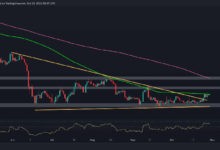Recent Bitcoin Token Deluge Illustrates Threat to Network Viability

The Bitcoin network experienced a historic run in the past month — not in market price — but in traffic and transaction fees. Fees spiked 35 times higher than normal, mostly due to a surge in on-chain activity with the rise of Ordinals and the novel BRC-20 token.
Made possible by the Taproot upgrade implemented in 2021, Ordinals allow users to inscribe text, images and code on a single satoshi — the smallest increment of a bitcoin. Traffic recently flooded the network as non-fungible tokens and marketplaces that have traditionally been more at home on smart-contract platforms like Ethereum and Solana sprung into existence.
A backlog of hundreds of thousands of pending transactions jammed the network, causing delays, higher fees and frustration for many users.
During the Empire podcast, Lyn Alden, Founder of Lyn Alden Investment Strategy, and Jordi Alexander, chief investment officer of Selini Capital, spoke to Blockworks about the recent, overwhelming influx of tokens on the Bitcoin network.
Alden recalls an article she wrote years ago about “use cases we don’t see right now that might emerge in the future for demanding block space other than just transactions.”
“They kind of come in waves and this is the latest wave.”
“This is the market at work,” Alden says. “Right now, there’s a big new speculative use case as of this talk, and this could change in minutes, hours or days, but right now the fee spikes have already subsided for the most part.”
Alden says the latest token craze does not have long-term sustainability. This sort of “speculative action,” she says, “exhausts itself because there’s only so much capital they have to pay for fees to play these games.”
“They only have so many followers that they can use as exit liquidity in this big speculation pump and dump.”
Critics are overreacting
Alden says critics of the network are overreacting to the situation and that Bitcoin “maxis” who suggested censorship of the tokens as spam just need to let things “play out.”
Over the long term, more consensus changes like SegWit and Taproot could be useful for optimizing the network, she says. “But I think it’s in a healthy state. I think it’s doing what it’s supposed to do.”
Alexander suggests other possible approaches to the problem. “There will have to be some kind of solution at some point. Either they’ll segment the block space in certain ways or maybe create some kind of rollup where certain things happen.”
Alden is confident that fees will “sort it out over time.”
“Constraints are the source for creativity.”
“When designers have constraints to work around, that’s where innovation tends to happen,” she says. “For a while, people have said, why isn’t there more layer-two activity on Bitcoin?”
“Why would there be when base-layer transactions are like 75 cents, and most people prefer to hodl their bitcoin rather than actively spend it?”
“Compared to the size of the base-layer,” Alden says, “L2s have been small. And that’s partially because there’s been no constraint.”
“There’s been very little fee pressure at most times.”
The brief periods of higher fee pressure, like the recent token influx, Alden says, are “catalysts for change.”
Alden argues that the necessary changes are already taking place, citing the implementation of the Lightning Network and the adoption of more efficient batch transactions by exchanges as evidence.
“And that’s in response to fees.”
“I think that the incentives and the foundation are already there.”







 Bitcoin
Bitcoin  Ethereum
Ethereum  Tether
Tether  USDC
USDC  Dogecoin
Dogecoin  Cardano
Cardano  TRON
TRON  Bitcoin Cash
Bitcoin Cash  Chainlink
Chainlink  Polygon
Polygon  Litecoin
Litecoin  LEO Token
LEO Token  Dai
Dai  Ethereum Classic
Ethereum Classic  Hedera
Hedera  Stacks
Stacks  Cronos
Cronos  Stellar
Stellar  Cosmos Hub
Cosmos Hub  OKB
OKB  Maker
Maker  Theta Network
Theta Network  Monero
Monero  Algorand
Algorand  NEO
NEO  Gate
Gate  Tezos
Tezos  KuCoin
KuCoin  EOS
EOS  Synthetix Network
Synthetix Network  IOTA
IOTA  Bitcoin Gold
Bitcoin Gold  Tether Gold
Tether Gold  TrueUSD
TrueUSD  Enjin Coin
Enjin Coin  Zilliqa
Zilliqa  Holo
Holo  Ravencoin
Ravencoin  0x Protocol
0x Protocol  Siacoin
Siacoin  Qtum
Qtum  Basic Attention
Basic Attention  Dash
Dash  Zcash
Zcash  NEM
NEM  Decred
Decred  Ontology
Ontology  Lisk
Lisk  Waves
Waves  DigiByte
DigiByte  Status
Status  Numeraire
Numeraire  Nano
Nano  Pax Dollar
Pax Dollar  Hive
Hive  Steem
Steem  Huobi
Huobi  OMG Network
OMG Network  BUSD
BUSD  Ren
Ren  Bytom
Bytom  Bitcoin Diamond
Bitcoin Diamond  Kyber Network Crystal Legacy
Kyber Network Crystal Legacy  HUSD
HUSD  Energi
Energi  Augur
Augur